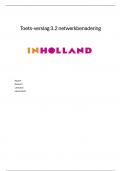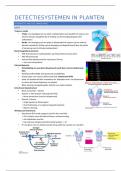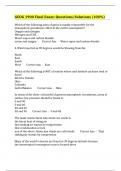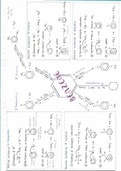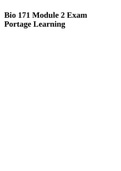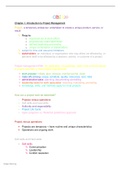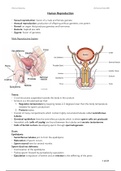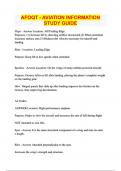Summary Public Relations
November/December 2021
Week 2: Crisis Communication
1. Ndlela, M.N. (2019). Introduction. Crisis Communication: A Stakeholder Approach.
Palgrave, London.
2. Ndlela, M.N. (2019). Stakeholder Approaches in Crisis Management. Crisis
Communication: A Stakeholder Approach. Palgrave, London.
3. Triantafillidou, A., & Yannas, P. (2020). Social media crisis communication in
racially charged crises: Exploring the effects of social media and image
restoration strategies. Computers in human behavior, 106, 106269.
4. Lee, S. Y., & Atkinson, L. (2019). Never easy to say “sorry”: Exploring the interplay
of crisis involvement, brand image, and message appeal in developing
effective corporate apologies. Public Relations Review, 45(1), 178-188.
Week 3: Media Effects
5. Deephouse, D. L. (2000). Media reputation as a strategic resource: An integration of
mass communication and resource-based theories. Journal of Management,
26(6), 1091–1112.
6. Etter, M., Ravasi, D., & Colleoni, E. (2019). Social media and the formation of
organizational reputation. Academy of Management Review, 44(1), 28–52.
7. Dijkmans, C., Kerkhof, P., Buyukcan-Tetik, A., & Beukeboom, C. J. (2015). Online
conversation and corporate reputation: A two-wave longitudinal study on the
effects of exposure to the social media activities of a highly interactive
company. Journal of Computer-Mediated Communication, 20(6), 632-648.
8. Jonkman, J. G. F., Boukes, M., Vliegenthart, R., & Verhoeven, P. (2020). Buffering
negative news: Individual-level effects of company visibility, tone, and pre-
existing attitudes on corporate reputation. Mass Communication and Society,
23(2), 272–296.
Week 4: Webcare
9. Einwiller, S. A., & Steilen, S. (2015). Handling complaints on social network sites–
An analysis of complaints and complaint responses on Facebook and Twitter
pages of large US companies. Public relations review, 41(2), 195-204.
10. Van Noort, G., Willemsen, L. M., Kerkhof, P., & Verhoeven, J. W. (2015). Webcare
as an integrative tool for customer care, reputation management, and online
marketing: A literature review. Integrated communications in the postmodern
era, 77-99.
11. Javornik, A., Filieri, R., & Gumann, R. (2020). “Don't forget that others are watching,
too!” the effect of conversational human voice and reply length on observers'
perceptions of complaint handling in social media. Journal of Interactive
Marketing, 50, 100-119.
1
,Week 5: Corporate Social Responsibility
12. Diogo Hildebrand, Sankar Sen, C.B. Bhattacharya, (2011),"Corporate social
responsibility: a corporate marketing perspective", European Journal of
Marketing, Vol. 45 Iss: 9 pp. 1353 – 1364
13. Orazi, D. C., & Chan, E. Y. (2020). “They did not walk the green talk!” How
information specificity influences consumer evaluations of disconfirmed
environmental claims. Journal of Business Ethics, 163(1), 107-123.
14. Bigné, E., Currás‐Pérez, R., & Aldás‐Manzano, J. (2012). Dual nature of cause‐brand
fit: Influence on corporate social responsibility consumer
perception. European Journal of Marketing.
Week 6: Internal Communication
15. Verčič, A. T., Verčič, D., & Sriramesh, K. (2012). Internal communication:
Definition, parameters, and the future. Public relations review, 38(2), 223-
230.
16. Men, L. R. (2015). The internal communication role of the chief executive officer:
Communication channels, style, and effectiveness. Public Relations Review,
41(4), 461-471.
17. Kim, D. (2018). Examining effects of internal public relations practices on
organizational social capital in the Korean context: Mediating roles of
employee-organization relationships. Corporate Communications: An
International Journal,23(1), 100-116.
2
, 1. Ndlela (2019): Crisis Communication: Chapter 1 (Introduction)
In the era of crisis
Organizational crises:
- Industrial accidents, misconduct, harassment, discrimination, unethical conduct, faulty
products, shoddy services, unethical behavior
- Afflicting organizations and their stakeholders
- Area of vulnerability = social media
Crisis prevention = first step is awareness
Defining organizational crisis
Crisis:
- Different events or circumstances that are deemed to have negative impacts on
individuals, organizations, or society
- No clear boundaries as to what constitutes a crisis:
o Clearly visible crises = natural disasters
o Invisible crises
o Crises based on contested perceptions = misdeeds in an organization
Good crisis management (Bland, 1998):
- Balance of judgements at the earliest stages
- Best to have a low threshold when defining crisis
- Be prepared for an incident to escalate into a crisis
Stakeholder = “any group or individual who is affected by or can affect the achievement of an
organization’s objective” (Freeman, 1984)
Characteristics of organizational crisis
Three characteristics separating crises from other unpleasant situations (Hermann, 1963):
1. Threat = threatens the high-priority values of an organization
2. Surprise = is unexpected or unanticipated
3. Short response time = presents a restricted time in which to respond
Three characteristics of crisis (Lerbinger, 1997):
1. Suddenness
o Can also be build up gradually = presence of warning signals
2. Uncertainty
o Complex environment of organization = difficult to obtain sufficient
information
3. Time compression
o Decisions must be made under stress
Crises (Gregory, 2005) = “High consequence, low probability, overlaid with risk and
uncertainty, conducted under time pressure, disruptive or normal business and potentially
lethal to organization reputation”
3
, Dimensions of crises (Pearson & Mitroff, 1993) = “Highly visible, contain an element of
surprise, require action and are outside an organization’s complete control”
Crisis typologies
Different classifications of crisis (Seeger, 2013):
Tempo or progression:
- Sudden crises:
o Situations that occur suddenly, without warning
o Go beyond an organization’s control
o Accidents = unplanned, unexpected and undersigned events that occur
suddenly and cause injury or loss, a decrease in the value of resources or an
increase in liabilities
- Smouldering crises:
o Slow-moving and not clearly visible
o Government regulation actions, consumer activism, rumors, bribery,
mismanagement, whistly-blowing, etc.
Situational crisis communication theory (SCCT) (Coombs, 2015):
- Organizational crises divided in three clusters:
o Victim cluster:
§ Organization has not caused the crisis but is itself also a victim
§ Examples = natural disasters or acts of malevolence
o Accidental cluster:
§ Organizational actions leading to the crisis were unintentional
§ Examples = technical failures
o Preventable cluster:
§ Organization’s inappropriate actions led to the crisis
§ Examples = human errors and misconduct on the part of an
organization
- Assumption:
o Crises in same cluster will have underlying similarities
o Allows crisis managers to have one crisis plan that can be applied to multiple
crises
4
November/December 2021
Week 2: Crisis Communication
1. Ndlela, M.N. (2019). Introduction. Crisis Communication: A Stakeholder Approach.
Palgrave, London.
2. Ndlela, M.N. (2019). Stakeholder Approaches in Crisis Management. Crisis
Communication: A Stakeholder Approach. Palgrave, London.
3. Triantafillidou, A., & Yannas, P. (2020). Social media crisis communication in
racially charged crises: Exploring the effects of social media and image
restoration strategies. Computers in human behavior, 106, 106269.
4. Lee, S. Y., & Atkinson, L. (2019). Never easy to say “sorry”: Exploring the interplay
of crisis involvement, brand image, and message appeal in developing
effective corporate apologies. Public Relations Review, 45(1), 178-188.
Week 3: Media Effects
5. Deephouse, D. L. (2000). Media reputation as a strategic resource: An integration of
mass communication and resource-based theories. Journal of Management,
26(6), 1091–1112.
6. Etter, M., Ravasi, D., & Colleoni, E. (2019). Social media and the formation of
organizational reputation. Academy of Management Review, 44(1), 28–52.
7. Dijkmans, C., Kerkhof, P., Buyukcan-Tetik, A., & Beukeboom, C. J. (2015). Online
conversation and corporate reputation: A two-wave longitudinal study on the
effects of exposure to the social media activities of a highly interactive
company. Journal of Computer-Mediated Communication, 20(6), 632-648.
8. Jonkman, J. G. F., Boukes, M., Vliegenthart, R., & Verhoeven, P. (2020). Buffering
negative news: Individual-level effects of company visibility, tone, and pre-
existing attitudes on corporate reputation. Mass Communication and Society,
23(2), 272–296.
Week 4: Webcare
9. Einwiller, S. A., & Steilen, S. (2015). Handling complaints on social network sites–
An analysis of complaints and complaint responses on Facebook and Twitter
pages of large US companies. Public relations review, 41(2), 195-204.
10. Van Noort, G., Willemsen, L. M., Kerkhof, P., & Verhoeven, J. W. (2015). Webcare
as an integrative tool for customer care, reputation management, and online
marketing: A literature review. Integrated communications in the postmodern
era, 77-99.
11. Javornik, A., Filieri, R., & Gumann, R. (2020). “Don't forget that others are watching,
too!” the effect of conversational human voice and reply length on observers'
perceptions of complaint handling in social media. Journal of Interactive
Marketing, 50, 100-119.
1
,Week 5: Corporate Social Responsibility
12. Diogo Hildebrand, Sankar Sen, C.B. Bhattacharya, (2011),"Corporate social
responsibility: a corporate marketing perspective", European Journal of
Marketing, Vol. 45 Iss: 9 pp. 1353 – 1364
13. Orazi, D. C., & Chan, E. Y. (2020). “They did not walk the green talk!” How
information specificity influences consumer evaluations of disconfirmed
environmental claims. Journal of Business Ethics, 163(1), 107-123.
14. Bigné, E., Currás‐Pérez, R., & Aldás‐Manzano, J. (2012). Dual nature of cause‐brand
fit: Influence on corporate social responsibility consumer
perception. European Journal of Marketing.
Week 6: Internal Communication
15. Verčič, A. T., Verčič, D., & Sriramesh, K. (2012). Internal communication:
Definition, parameters, and the future. Public relations review, 38(2), 223-
230.
16. Men, L. R. (2015). The internal communication role of the chief executive officer:
Communication channels, style, and effectiveness. Public Relations Review,
41(4), 461-471.
17. Kim, D. (2018). Examining effects of internal public relations practices on
organizational social capital in the Korean context: Mediating roles of
employee-organization relationships. Corporate Communications: An
International Journal,23(1), 100-116.
2
, 1. Ndlela (2019): Crisis Communication: Chapter 1 (Introduction)
In the era of crisis
Organizational crises:
- Industrial accidents, misconduct, harassment, discrimination, unethical conduct, faulty
products, shoddy services, unethical behavior
- Afflicting organizations and their stakeholders
- Area of vulnerability = social media
Crisis prevention = first step is awareness
Defining organizational crisis
Crisis:
- Different events or circumstances that are deemed to have negative impacts on
individuals, organizations, or society
- No clear boundaries as to what constitutes a crisis:
o Clearly visible crises = natural disasters
o Invisible crises
o Crises based on contested perceptions = misdeeds in an organization
Good crisis management (Bland, 1998):
- Balance of judgements at the earliest stages
- Best to have a low threshold when defining crisis
- Be prepared for an incident to escalate into a crisis
Stakeholder = “any group or individual who is affected by or can affect the achievement of an
organization’s objective” (Freeman, 1984)
Characteristics of organizational crisis
Three characteristics separating crises from other unpleasant situations (Hermann, 1963):
1. Threat = threatens the high-priority values of an organization
2. Surprise = is unexpected or unanticipated
3. Short response time = presents a restricted time in which to respond
Three characteristics of crisis (Lerbinger, 1997):
1. Suddenness
o Can also be build up gradually = presence of warning signals
2. Uncertainty
o Complex environment of organization = difficult to obtain sufficient
information
3. Time compression
o Decisions must be made under stress
Crises (Gregory, 2005) = “High consequence, low probability, overlaid with risk and
uncertainty, conducted under time pressure, disruptive or normal business and potentially
lethal to organization reputation”
3
, Dimensions of crises (Pearson & Mitroff, 1993) = “Highly visible, contain an element of
surprise, require action and are outside an organization’s complete control”
Crisis typologies
Different classifications of crisis (Seeger, 2013):
Tempo or progression:
- Sudden crises:
o Situations that occur suddenly, without warning
o Go beyond an organization’s control
o Accidents = unplanned, unexpected and undersigned events that occur
suddenly and cause injury or loss, a decrease in the value of resources or an
increase in liabilities
- Smouldering crises:
o Slow-moving and not clearly visible
o Government regulation actions, consumer activism, rumors, bribery,
mismanagement, whistly-blowing, etc.
Situational crisis communication theory (SCCT) (Coombs, 2015):
- Organizational crises divided in three clusters:
o Victim cluster:
§ Organization has not caused the crisis but is itself also a victim
§ Examples = natural disasters or acts of malevolence
o Accidental cluster:
§ Organizational actions leading to the crisis were unintentional
§ Examples = technical failures
o Preventable cluster:
§ Organization’s inappropriate actions led to the crisis
§ Examples = human errors and misconduct on the part of an
organization
- Assumption:
o Crises in same cluster will have underlying similarities
o Allows crisis managers to have one crisis plan that can be applied to multiple
crises
4

